The Source and Evolution of Ore-Forming Fluids in the Xiaobaihegou Fluorite Deposit, Altyn-Tagh Orogen, NW China: Constraints from Trace Element, Fluid Inclusion, and Isotope Studies
Abstract
1. Introduction
2. Geological Background
3. Geology of the Xiaobaihegou Fluorite Deposit
4. Sampling and Analytical Methods
4.1. Zircon U-Pb Geochronology
4.2. Analysis of Major and Trace Elements
4.3. Fluid Inclusion Analysis
4.4. Isotope Analysis
5. Results
5.1. Zircon U-Pb Ages
5.2. Major and Trace Elements
| Sample | XBH-1 | XBH-2 | XBH-3 | XBH-4 | XBH-5 | XBH-6 | XBH-7 | XBH-8 | XBH-9 | XBH-10 | XBH-11 | XBH-12 | XBH-13 |
|---|---|---|---|---|---|---|---|---|---|---|---|---|---|
| Early Fluorite | Early Fluorite | Early Fluorite | Early Fluorite | Early Fluorite | Late Fluorite | Late Fluorite | Late Fluorite | Late Fluorite | Late Fluorite | Late Fluorite | Late Fluorite | Late Fluorite | |
| Cs | 0.01 | 0.02 | 0.08 | 0.03 | 2.29 | 0.09 | 0.01 | 0.01 | 0.01 | 1.06 | 0.25 | 0.31 | 0.35 |
| Pb | 3.35 | 4.78 | 5.69 | 5.78 | 26.9 | 5.78 | 5.67 | 2.25 | 4.96 | 17.5 | 3.11 | 1.99 | 9.18 |
| Rb | 0.23 | 0.14 | 0.19 | 0.23 | 49.8 | 2.78 | 0.46 | 0.57 | 0.13 | 23.2 | 5.46 | 6.22 | 3.70 |
| Ba | 1.12 | 1.35 | 2.18 | 1.08 | 92.1 | 2.86 | 31.4 | 0.93 | 1.18 | 40.7 | 12.3 | 11.6 | 5.97 |
| Th | 0.24 | 0.19 | 0.10 | 0.09 | 2.20 | 0.65 | 0.28 | 0.22 | 0.07 | 1.29 | 0.59 | 0.51 | 2.70 |
| U | 0.25 | 0.26 | 0.19 | 0.33 | 1.51 | 0.71 | 0.64 | 0.69 | 0.53 | 2.13 | 1.10 | 0.61 | 1.85 |
| Ta | 0.15 | 0.14 | 0.08 | 0.09 | 0.04 | 0.20 | 0.12 | 0.09 | 0.18 | 0.04 | 0.01 | 0.01 | 0.01 |
| Nb | 0.19 | 0.18 | 0.16 | 0.18 | 3.48 | 0.55 | 0.59 | 0.25 | 0.28 | 4.82 | 1.29 | 0.47 | 3.79 |
| Zr | 4.04 | 2.97 | 1.79 | 1.57 | 8.75 | 10.9 | 10.8 | 4.83 | 1.27 | 4.20 | 0.73 | 0.84 | 0.79 |
| Hf | 0.36 | 0.32 | 0.27 | 0.26 | 0.26 | 0.38 | 0.38 | 0.25 | 0.15 | 0.12 | 0.02 | 0.03 | 0.02 |
| Ti | 0.00 | 0.00 | 0.00 | 22.3 | 95.0 | 0.00 | 918 | 23.4 | 0.00 | 53.4 | 16.1 | 15.4 | 8.08 |
| Sr | 358 | 354 | 323 | 371 | 348 | 405 | 402 | 414 | 394 | 384 | 419 | 388 | 425 |
| La | 7.46 | 8.26 | 8.40 | 7.97 | 18.7 | 4.47 | 5.12 | 4.00 | 5.16 | 12.0 | 12.4 | 7.83 | 8.78 |
| Ce | 26.0 | 27.1 | 26.3 | 26.4 | 37.8 | 14.1 | 16.2 | 13.3 | 16.9 | 25.6 | 29.1 | 22.5 | 20.4 |
| Pr | 4.13 | 4.24 | 3.91 | 4.22 | 4.33 | 2.18 | 2.47 | 2.10 | 2.57 | 3.14 | 3.78 | 3.48 | 2.66 |
| Nd | 21.9 | 22.2 | 20.4 | 22.1 | 16.7 | 10.9 | 12.3 | 10.5 | 12.9 | 12.9 | 16.3 | 17.5 | 11.4 |
| Sm | 6.33 | 6.57 | 5.99 | 6.43 | 3.30 | 3.07 | 3.35 | 2.99 | 3.69 | 2.78 | 3.70 | 4.80 | 2.68 |
| Eu | 0.82 | 0.83 | 0.79 | 0.83 | 0.51 | 0.40 | 0.43 | 0.39 | 0.47 | 0.40 | 0.53 | 0.68 | 0.39 |
| Gd | 8.10 | 8.30 | 7.61 | 8.21 | 3.40 | 3.67 | 3.98 | 3.55 | 4.39 | 2.83 | 4.01 | 5.88 | 2.92 |
| Tb | 1.14 | 1.15 | 1.06 | 1.16 | 0.48 | 0.50 | 0.56 | 0.49 | 0.61 | 0.42 | 0.60 | 0.86 | 0.43 |
| Dy | 7.46 | 7.65 | 6.91 | 7.53 | 2.85 | 3.22 | 3.49 | 3.20 | 3.94 | 2.49 | 3.59 | 5.47 | 2.58 |
| Ho | 1.60 | 1.63 | 1.48 | 1.61 | 0.59 | 0.69 | 0.72 | 0.66 | 0.84 | 0.52 | 0.75 | 1.15 | 0.54 |
| Er | 4.33 | 4.44 | 4.05 | 4.35 | 1.71 | 1.86 | 1.98 | 1.82 | 2.27 | 1.50 | 2.21 | 3.40 | 1.57 |
| Tm | 0.64 | 0.63 | 0.58 | 0.62 | 0.23 | 0.27 | 0.29 | 0.27 | 0.33 | 0.20 | 0.30 | 0.46 | 0.21 |
| Yb | 3.71 | 3.77 | 3.49 | 3.75 | 1.39 | 1.61 | 1.71 | 1.62 | 1.96 | 1.20 | 1.85 | 2.70 | 1.26 |
| Lu | 0.50 | 0.52 | 0.47 | 0.52 | 0.19 | 0.22 | 0.24 | 0.22 | 0.27 | 0.17 | 0.26 | 0.38 | 0.18 |
| Y | 133 | 133 | 124 | 133 | 41.6 | 54.5 | 55.1 | 52.8 | 65.1 | 38.1 | 57.8 | 98.8 | 42.4 |
| ΣREE | 94.1 | 97.3 | 91.5 | 95.7 | 92.2 | 47.2 | 52.8 | 45.1 | 56.3 | 66.2 | 79.5 | 77.1 | 56.0 |
| LREEs | 66.6 | 69.2 | 65.8 | 68.0 | 81.3 | 35.1 | 39.9 | 33.3 | 41.7 | 56.9 | 65.9 | 56.8 | 46.4 |
| HREEs | 27.5 | 28.1 | 25.7 | 27.8 | 10.9 | 12.0 | 13.0 | 11.8 | 14.6 | 9.33 | 13.6 | 20.3 | 9.68 |
| LREE/HREE | 2.42 | 2.46 | 2.56 | 2.45 | 7.49 | 2.92 | 3.08 | 2.81 | 2.85 | 6.09 | 4.86 | 2.80 | 4.79 |
| (La/Yb)N | 1.44 | 1.57 | 1.73 | 1.52 | 9.66 | 1.99 | 2.15 | 1.77 | 1.89 | 7.14 | 4.81 | 2.08 | 4.98 |
| δEu | 0.35 | 0.34 | 0.36 | 0.35 | 0.46 | 0.36 | 0.36 | 0.36 | 0.36 | 0.43 | 0.42 | 0.39 | 0.42 |
| δCe | 1.15 | 1.12 | 1.13 | 1.12 | 1.03 | 1.11 | 1.12 | 1.13 | 1.14 | 1.02 | 1.04 | 1.06 | 1.04 |
| Sample | XBH-20 | XBH-21 | XBH-22 | XBH-23 | XBH-24 | XBH-25 | XBH-26 | XBH-27 | XBH-28 | XBH-29 | XBH-30 | ||
| Calcite | Calcite | Calcite | Calcite | Calcite | Calcite | Calcite | Calcite | Calcite | Calcite | Calcite | |||
| Cs | 0.06 | 0.05 | 0.05 | 0.06 | 0.05 | 0.05 | 0.06 | 0.06 | 0.09 | 0.04 | 0.61 | ||
| Pb | 64.8 | 56.8 | 54.6 | 64.6 | 53.2 | 52.8 | 53.1 | 57.8 | 62.5 | 60.2 | 56.5 | ||
| Rb | 0.10 | 0.49 | 0.25 | 0.13 | 0.65 | 0.35 | 0.62 | 0.82 | 1.02 | 0.10 | 3.83 | ||
| Ba | 48.3 | 41.4 | 53.9 | 57.0 | 62.7 | 71.4 | 51.2 | 44.1 | 30.7 | 40.9 | 26.1 | ||
| Th | 0.10 | 0.10 | 0.08 | 0.08 | 0.17 | 0.08 | 0.09 | 0.03 | 0.03 | 0.05 | 0.04 | ||
| U | 0.05 | 0.04 | 0.04 | 0.04 | 0.05 | 0.03 | 0.04 | 0.03 | 0.03 | 0.03 | 0.07 | ||
| Ta | 0.02 | 0.01 | 0.05 | 0.02 | 0.02 | 0.01 | 0.01 | 0.01 | 0.01 | 0.01 | 0.01 | ||
| Nb | 0.02 | 0.01 | 0.01 | 0.02 | 0.01 | 0.01 | 0.01 | 0.02 | 0.01 | 0.01 | 0.01 | ||
| Zr | 0.11 | 0.00 | 0.22 | 0.23 | 0.03 | 0.10 | 0.20 | 0.20 | 0.26 | 0.06 | 0.12 | ||
| Hf | 0.06 | 0.09 | 0.07 | 0.04 | 0.05 | 0.07 | 0.04 | 0.09 | 0.06 | 0.03 | 0.07 | ||
| Ti | 0.54 | 0.54 | 0.60 | 0.66 | 0.47 | 0.70 | 0.71 | 0.53 | 0.41 | 0.48 | 0.54 | ||
| Sr | 1198 | 1191 | 1173 | 1211 | 1193 | 1240 | 1188 | 1204 | 1173 | 1233 | 1220 | ||
| La | 51.8 | 63.4 | 62.9 | 60.8 | 67.8 | 56.4 | 49.9 | 65.1 | 63.0 | 68.9 | 74.1 | ||
| Ce | 131 | 146 | 142 | 150 | 150 | 143 | 125 | 148 | 143 | 153 | 168 | ||
| Pr | 15.6 | 15.6 | 15.8 | 17.0 | 16.7 | 15.9 | 14.5 | 16.7 | 16.0 | 17.0 | 17.6 | ||
| Nd | 59.2 | 60.5 | 60.6 | 62.8 | 63.3 | 60.1 | 56.5 | 62.8 | 61.7 | 64.8 | 67.0 | ||
| Sm | 10.1 | 11.5 | 11.1 | 12.4 | 11.9 | 11.5 | 9.95 | 12.1 | 11.4 | 11.2 | 11.6 | ||
| Eu | 1.36 | 1.30 | 1.35 | 1.38 | 1.46 | 1.35 | 1.34 | 1.41 | 1.44 | 1.41 | 1.32 | ||
| Gd | 8.61 | 8.53 | 8.03 | 8.21 | 8.48 | 8.91 | 8.50 | 8.63 | 8.42 | 8.47 | 8.35 | ||
| Tb | 1.27 | 1.25 | 1.36 | 1.37 | 1.38 | 1.36 | 1.32 | 1.33 | 1.29 | 1.40 | 1.44 | ||
| Dy | 7.79 | 7.59 | 7.65 | 8.30 | 7.53 | 8.21 | 7.47 | 7.79 | 8.03 | 7.49 | 7.91 | ||
| Ho | 1.62 | 1.55 | 1.62 | 1.70 | 1.72 | 1.75 | 1.68 | 1.73 | 1.69 | 1.75 | 1.67 | ||
| Er | 4.82 | 4.69 | 5.15 | 4.84 | 5.07 | 4.74 | 4.91 | 4.95 | 4.88 | 4.89 | 4.89 | ||
| Tm | 0.74 | 0.73 | 0.73 | 0.71 | 0.73 | 0.67 | 0.75 | 0.77 | 0.70 | 0.75 | 0.77 | ||
| Yb | 5.42 | 5.65 | 5.73 | 6.03 | 5.86 | 5.30 | 6.06 | 5.85 | 5.50 | 5.81 | 5.82 | ||
| Lu | 0.85 | 0.86 | 0.81 | 0.85 | 0.88 | 0.88 | 0.93 | 0.82 | 0.84 | 0.88 | 0.86 | ||
| Y | 41.7 | 41.4 | 41.5 | 42.3 | 42.6 | 42.6 | 43.0 | 42.9 | 42.3 | 42.3 | 42.6 | ||
| ΣREE | 1487 | 1509 | 1486 | 1536 | 1523 | 1549 | 1465 | 1531 | 1489 | 1569 | 1579 | ||
| LREEs | 1381 | 1401 | 1378 | 1423 | 1411 | 1440 | 1364 | 1418 | 1379 | 1456 | 1462 | ||
| HREEs | 106 | 108 | 108 | 113 | 113 | 109 | 101 | 113 | 110 | 114 | 117 | ||
| LREE/HREE | 13.1 | 13.0 | 12.8 | 12.6 | 12.6 | 13.2 | 13.5 | 12.6 | 12.5 | 12.8 | 12.5 | ||
| (La/Yb)N | 6.49 | 7.63 | 7.46 | 6.85 | 7.86 | 7.23 | 5.59 | 7.56 | 7.78 | 8.05 | 8.65 | ||
| δEu | 0.43 | 0.38 | 0.42 | 0.39 | 0.42 | 0.39 | 0.43 | 0.40 | 0.43 | 0.42 | 0.39 | ||
| δCe | 1.10 | 1.09 | 1.06 | 1.11 | 1.05 | 1.14 | 1.11 | 1.06 | 1.06 | 1.05 | 1.09 | ||
| Sample | XB1 | XB2 | XB3 | XB4 | XB5 | XB6 | XB7 |
|---|---|---|---|---|---|---|---|
| Major element (wt.%) | |||||||
| SiO2 | 73.1 | 74.7 | 74.3 | 75.3 | 75.0 | 73.6 | 73.1 |
| Al2O3 | 15.0 | 14.7 | 14.6 | 14.0 | 14.3 | 12.6 | 15.0 |
| Fe2O3t | 1.68 | 0.76 | 0.99 | 0.79 | 0.88 | 1.73 | 0.85 |
| CaO | 0.43 | 0.54 | 0.62 | 0.63 | 0.59 | 1.20 | 0.54 |
| MgO | 0.10 | 0.14 | 0.14 | 0.14 | 0.13 | 0.69 | 0.13 |
| K2O | 3.91 | 5.07 | 4.51 | 4.20 | 4.12 | 7.76 | 6.57 |
| Na2O | 5.54 | 3.79 | 4.33 | 4.13 | 4.50 | 1.28 | 3.61 |
| P2O5 | 0.08 | 0.10 | 0.12 | 0.09 | 0.09 | 0.21 | 0.10 |
| TiO2 | 0.02 | 0.02 | 0.03 | 0.02 | 0.03 | 0.26 | 0.02 |
| LOI | 0.62 | 0.56 | 0.43 | 0.50 | 0.60 | 1.08 | 0.40 |
| Total | 99.9 | 99.8 | 99.6 | 99.3 | 99.6 | 99.3 | 99.9 |
| A/CNK | 0.60 | 0.67 | 0.64 | 0.64 | 0.63 | 0.75 | 0.68 |
| A/NK | 1.13 | 1.25 | 1.22 | 1.23 | 1.21 | 1.20 | 1.15 |
| ALK | 9.45 | 8.86 | 8.84 | 8.33 | 8.62 | 9.04 | 10.2 |
| Mg# | 10.6 | 26.7 | 21.9 | 26.0 | 22.6 | 44.1 | 23.3 |
| Trace element (ppm) | |||||||
| Bi | 1.65 | 0.22 | 0.45 | 0.23 | 0.39 | 0.10 | 2.63 |
| Li | 9.07 | 10.8 | 15.3 | 16.0 | 12.2 | 10.9 | 9.00 |
| Be | 5.93 | 9.01 | 8.51 | 6.82 | 8.17 | 1.09 | 7.25 |
| Sc | 1.81 | 1.32 | 0.81 | 0.76 | 0.83 | 4.20 | 0.96 |
| Co | 1.60 | 2.61 | 2.02 | 1.92 | 2.01 | 5.45 | 1.96 |
| Cu | 3.48 | 6.08 | 3.48 | 2.77 | 3.89 | 4.58 | 2.33 |
| Zn | 8.04 | 34.8 | 42.5 | 29.7 | 30.8 | 31.7 | 43.2 |
| Ga | 16.7 | 20.6 | 18.0 | 19.3 | 20.5 | 13.5 | 23.4 |
| Rb | 279 | 475 | 427 | 372 | 396 | 297 | 498 |
| Sr | 57.7 | 21.1 | 16.6 | 20.8 | 24.9 | 80.6 | 19.0 |
| Zr | 23.8 | 17.1 | 17.8 | 16.1 | 18.8 | 105 | 10.8 |
| Nb | 12.1 | 17.5 | 16.0 | 11.9 | 15.3 | 5.11 | 21.1 |
| Cs | 9.56 | 22.9 | 14.1 | 11.5 | 12.2 | 6.97 | 18.6 |
| Ba | 77.9 | 76.8 | 61.5 | 91.4 | 84.4 | 670 | 75.7 |
| Hf | 1.22 | 1.29 | 1.09 | 0.97 | 1.16 | 3.48 | 0.62 |
| Ta | 2.94 | 1.73 | 1.59 | 1.11 | 1.44 | 0.35 | 2.01 |
| W | 20.0 | 1.17 | 1.13 | 0.83 | 1.12 | 0.75 | 1.26 |
| Tl | 1.55 | 2.01 | 1.74 | 1.53 | 1.64 | 1.42 | 2.18 |
| Pb | 36.5 | 37.9 | 35.1 | 31.1 | 31.0 | 27.1 | 32.2 |
| Th | 2.86 | 3.54 | 3.52 | 3.77 | 3.71 | 7.72 | 5.61 |
| U | 10.6 | 5.91 | 5.25 | 7.36 | 4.67 | 1.39 | 7.70 |
| La | 1.48 | 5.18 | 6.48 | 6.82 | 6.71 | 19.3 | 6.01 |
| Ce | 4.36 | 10.9 | 10.2 | 10.5 | 10.5 | 33.2 | 10.4 |
| Pr | 0.43 | 1.26 | 1.44 | 1.49 | 1.46 | 5.37 | 1.49 |
| Nd | 1.59 | 3.90 | 4.35 | 4.52 | 4.32 | 18.9 | 4.26 |
| Sm | 0.64 | 1.28 | 1.60 | 1.62 | 1.38 | 4.77 | 1.88 |
| Eu | 0.07 | 0.13 | 0.16 | 0.16 | 0.16 | 1.06 | 0.12 |
| Gd | 0.84 | 1.37 | 1.70 | 1.72 | 1.51 | 4.77 | 2.14 |
| Tb | 0.19 | 0.21 | 0.25 | 0.26 | 0.22 | 0.66 | 0.37 |
| Dy | 1.21 | 1.18 | 1.38 | 1.50 | 1.27 | 4.63 | 2.29 |
| Ho | 0.23 | 0.15 | 0.17 | 0.20 | 0.16 | 0.77 | 0.30 |
| Er | 0.67 | 0.45 | 0.47 | 0.52 | 0.48 | 2.43 | 0.78 |
| Tm | 0.11 | 0.06 | 0.06 | 0.07 | 0.06 | 0.30 | 0.10 |
| Yb | 0.76 | 0.42 | 0.45 | 0.50 | 0.45 | 1.86 | 0.67 |
| Lu | 0.10 | 0.06 | 0.07 | 0.07 | 0.07 | 0.26 | 0.09 |
| Y | 6.10 | 5.94 | 6.81 | 7.73 | 6.49 | 25.4 | 11.3 |
| ∑REE | 12.7 | 26.6 | 28.8 | 30.0 | 28.8 | 98.3 | 30.9 |
| LREEs | 8.57 | 22.7 | 24.2 | 25.1 | 24.5 | 82.6 | 24.2 |
| HREEs | 4.11 | 3.90 | 4.55 | 4.84 | 4.22 | 15.7 | 6.74 |
| LREE/HREE | 2.08 | 5.81 | 5.33 | 5.19 | 5.81 | 5.27 | 3.58 |
| (La/Yb)N | 0.63 | 4.00 | 4.67 | 4.42 | 4.83 | 3.36 | 2.91 |
| δEu | 0.28 | 0.30 | 0.30 | 0.29 | 0.34 | 0.68 | 0.18 |
| δCe | 1.31 | 1.03 | 0.80 | 0.79 | 0.81 | 0.78 | 0.84 |
5.3. Fluid Inclusions
5.4. C-H-O Isotopes Geochemistry
5.5. Sr-Nd Isotopic Compositions
6. Discussion
6.1. Timing of Fluorite Mineralization and Geodynamic Setting
6.2. Source of Ore-Forming Fluids
6.3. Fluid Evolution and Precipitation Mechanisms
6.4. Genetic Model of the Xiaobaihegou Fluorite Deposit
7. Conclusions
- (1)
- The Xiaobaihegou fluorite deposit is controlled by NE-trending secondary faults, which provide space for the orebodies. Fluorite mineralization is closely related to alkali-feldspar granite, and fluorite veins occur in fractures within or near the fracture zones of alkali-feldspar granite dykes. Most ore bodies extend >10 km in a discontinuous N-S trend. Mineralogy is simple, dominated by fluorite and calcite.
- (2)
- The formation age of the alkali-feldspar granite related to mineralization in Xiaobaihegou fluorite mine is 482.3 ± 4.1 Ma (MSWD = 0.016), which was formed in the Ordovician era.
- (3)
- The REE distribution pattern of the Xiaobaihegou deposit is of a right-leaning, LREE-enriched type with a significant negative Eu anomaly. This pattern is highly similar to that of the ore-forming alkali-feldspar granite, suggesting that the REE characteristics of fluorite and calcite may have been inherited from the granite.
- (4)
- The ore-forming process can be divided into an early and a late stage. Fluid inclusion studies indicate that the early-stage ore-forming fluids belong to a medium–high-temperature and -salinity fluid system, whereas the late-stage ore-forming fluids are characterized as medium–low-temperature and -salinity fluids. The ore-forming fluid primarily originates from magmatic–hydrothermal fluids and atmospheric precipitation.
- (5)
- The Sr-Nd isotopic composition of fluorite in the Xiaobaiheogou area shows that the ore-forming material originates from the crust. It is suggested that Ca may mainly comes from the leaching and extraction of the strata formation by the magmatic–hydrothermal solution, while F may mainly comes from the magmatic–hydrothermal solution.
Author Contributions
Funding
Data Availability Statement
Acknowledgments
Conflicts of Interest
References
- Magotra, R.; Namga, S.; Singh, P.; Arora, N.; Srivastava, P.K. A New Classification Scheme of Fluorite Deposits. Int. J. Geosci. 2017, 8, 599–610. [Google Scholar] [CrossRef]
- Han, B.B.; Shang, P.Q.; Gao, Y.Z.; Jiao, S.; Yao, C.M.; Zou, H.; Li, M.; Wang, L.; Zheng, H.Y. Fluorite deposits in China: Geological features, metallogenic regularity, and research progress. China Geol. 2020, 3, 473–489. [Google Scholar]
- Redina, A.A.; Nikolenko, A.M.; Doroshkevich, A.G.; Prokopyev, I.R.; Wohlgemuth-Ueberwasser, C.; Vladykin, N.V. Conditions for the crystallization of fluorite in the Mushgai-Khudag complex (Southern Mongolia): Evidence from trace element geochemistry and fluid inclusions. Geochem. Interdiscip. J. Chem. Probl. Geosci. Geoecol. 2020, 80, 125666. [Google Scholar] [CrossRef]
- Zou, H.; Li, M.; Santosh, M.; Zheng, D.; Cao, H.W.; Jiang, X.W.; Chen, H.F.; Li, Z.Q. Fault-controlled carbonate-hosted barite-fluorite mineral systems: The Shuanghe deposit, Yangtze Block, South China. Gondwana Res. Int. Geosci. J. 2022, 101, 26–43. [Google Scholar] [CrossRef]
- Gao, Y.B.; Zhang, L.; Bagas, L.; Hattori, K.; Liu, M.; Wu, H.H.; Wang, Y.W.; Chen, Z.Y.; Zhao, X.M.; Zhang, Y.; et al. Mineralogy and 40Ar-39Ar dating of the recently discovered tainiolite occurrences in the Kaerqiaer fluorite Belt, western Altyn Tagh Terrane. Ore Geol. Rev. 2024, 167, 105990. [Google Scholar] [CrossRef]
- Mineral Commodity Summaries 2025. Available online: https://pubs.usgs.gov/publication/mcs2025 (accessed on 3 March 2025).
- Wu, Y.P.; Zhang, L.C.; Yuan, B.; Zhou, Y.B.; Zhong, L.; Chen, S.Z.; Yang, G.J.; Yan, Y.W.; Zhang, X. Geological Character-istics and Genesis of the Super-large Kalqiar Fluorite Deposit in Altyn Tagh Area of Xinjiang, China. J. Earth Sci. Environ. 2021, 43, 962–977. [Google Scholar]
- Wu, Y.P.; Zhang, L.C.; Zhou, Y.B.; Zhu, M.T.; Chen, S.Z.; Zhong, L.; Yang, G.Q.; Yan, Y.W.; Liu, J.F. Study on fluid charac teristics and metallogenic mechanism of the super-large Kalqiar fluorite deposit in Altyn Tagh area. Chin. J. Geol. 2022, 57, 495–509. [Google Scholar]
- Zhao, X.M.; Gao, Y.B.; Yan, Z.Q.; Zhang, J.W.; Wang, B.; Jin, M.S. Genesis of Kalqiaer Super-large Fluorite Zone in Altyn Tagh Area: Chronology, Rare Earth Elements and Sr-Nd Isotopes Constraints. Northwestern Geol. 2023, 56, 31–47. [Google Scholar]
- Gao, Y.B.; Zhao, X.M.; Wang, B.; Zhang, J.W.; Jin, M.S.; Yang, S.F.; Yan, Z.Q.; Teng, J.X.; Zhao, H.B.; Chao, Y.Y. Geological characteristics, associated granites and the prospecting potential of the super-large Kaerqiaer-Kumutashi fluorite minerali-zation belt in the West Altyn-Tagh Orogen, NW China. Geol. China 2023, 50, 704–729. [Google Scholar]
- Yue, Y.; Liou, J.G. Two-stage evolution model for the Altyn Tagh fault, China. Geology 1999, 27, 227–230. [Google Scholar] [CrossRef]
- Liu, L.; Wang, C.; Chen, D.; Zhang, A.; Liou, J. Petrology and geochronology of HP-UHP rocks from the South Altyn Tagh, northwestern China. J. Asian Earth Sci. 2009, 35, 232–244. [Google Scholar] [CrossRef]
- Liu, L.; Wang, C.; Cao, Y.T.; Chen, D.L.; Kang, L.; Yang, W.Q.; Zhu, X.H. Geochronology of multi-stage metamorphic events: Constraints on episodic zircon growth from the UHP eclogite in the South Altyn, NW China. Lithos 2012, 136, 10–26. [Google Scholar] [CrossRef]
- Wang, C.; Liu, L.; Yang, W.Q.; Zhu, X.H.; Cao, Y.T.; Kang, L.; Chen, S.F.; Li, R.S.; He, S.P. Provenance and ages of the Altyn Complex in Altyn Tagh: Implications for the early Neoproterozoic evolution of northwestern China. Precambrian Res. 2013, 230, 193–208. [Google Scholar] [CrossRef]
- Wang, C.; Liu, L.; Xiao, P.X.; Cao, Y.T.; Yu, H.Y.; Meert, J.G.; Liang, W.T. Geochemical and geochronologic constraints for Paleozoic magmatism related to the orogenic collapse in the Qimantagh–South Altyn region, northwestern China. Lithos 2014, 202, 1–20. [Google Scholar] [CrossRef]
- Cao, Y.; Liu, L.; Wang, C.; Zhang, C.; Kang, L.; Yang, W.; Zhu, X. Multi-Stage Metamorphism of the UHP Pelitic Gneiss from the Southern Altyn Tagh HP/UHP Belt, Western China: Petrological and Geochronological Evidence. J. Earth Sci. 2019, 30, 603–620. [Google Scholar] [CrossRef]
- Gao, Y.; Zhao, X.; Bagas, L.; Wang, Y.; Jin, M.; Zhang, J.; Lu, L.; Gao, Y.; Yan, Z.; Teng, J. Newly discovered Ordovician Li-Be deposits at Tugeman in the Altyn-Tagh Orogen, NW China. Ore Geol. Rev. 2021, 139, 104515. [Google Scholar] [CrossRef]
- Zhang, J.; Zhang, Z.; Xu, Z.; Yang, J.; Cui, J. Petrology and geochronology of eclogites from the western segment of the Altyn Tagh, northwestern China. Lithos 2001, 56, 187–206. [Google Scholar] [CrossRef]
- Yu, S.; Zhang, J.; del Real, P.G.; Zhao, X.; Hou, K.; Gong, J.; Li, Y. The Grenvillian orogeny in the Altun–Qilian–North Qaidam mountain belts of northern Tibet Plateau: Constraints from geochemical and zircon U–Pb age and Hf isotopic study of magmatic rocks. J. Asian Earth Sci. 2013, 73, 372–395. [Google Scholar] [CrossRef]
- NIST610; Certificate of Analysis: Standard Reference Material 610-Trace Elements in Glass (Revision 2023-01). National Institute of Standards and Technology (NIST): Gaithersburg, MD, USA, 1993.
- Wiedenbeck, M.; Alle, P.; Corfu, F.; Griffin, W.L.; Meier, M.; Oberli, F.V.; Quadt, A.V.; Roddick, J.; Spiegel, W. Three natural zircon standards for U-Th-Pb, Lu-Hf, trace element and REE analyses. Geostand. Newsl. 1995, 19, 1–23. [Google Scholar] [CrossRef]
- Liu, Y.; Gao, S.; Hu, Z.; Gao, C.; Zong, K.; Wang, D. Continental and oceanic crust recycling-induced melt–peridotite interactions in the Trans-North China Orogen: U–Pb dating, Hf isotopes and trace elements in zircons from mantle xenoliths. J. Petrol. 2010, 51, 537–571. [Google Scholar] [CrossRef]
- Ludwig, K.R. User’s Manual for ISOPLOT 3.00: A Geochronological Toolkit for Microsoft Excel, Special Publication No. 4; Berkeley Geochronology Center: Berkeley, CA, USA, 2003; p. 71. [Google Scholar]
- Ludwig, K.R. Mathematical–statistical treatment of data and errors for 230Th/U geochronology. Rev. Mineral. Geochem. 2003, 52, 631–656. [Google Scholar] [CrossRef]
- NIST SRM 987; Certificate of Analysis: Standard Reference Material 987-Strontium Carbonate Isotopic Standard. National Institute of Standards and Technology (NIST): Gaithersburg, MD, USA, 2023.
- Zhai, M.G. Granites: Leading study issue for continental evolution. Acta Petrol. Sin. 2017, 33, 1369–1380. [Google Scholar]
- McDonough, W.F.; Sun, S.S. The composition of the Earth. Chem. Geol. 1995, 120, 223–253. [Google Scholar] [CrossRef]
- Roedder, E. Volume 12: Fluid inclusions. Rev. Miner. 1984, 12, 644. [Google Scholar]
- Zhang, Y.; Gao, Y.B.; Liu, M.; Wang, Y.W.; Chen, K.; Zhang, L.; Jing, Y.K.; Liu, J.Y. The Characteristics of Ore-forming Fluids and Metallogenic Mecha nism of the Kumutashi Fluorite Deposit in West Altyn-Tagh, China. Northwestern Geol. 2024, 57, 21–36. [Google Scholar]
- Goldstein, S.; O’nions, R.; Hamilton, P. A Sm-Nd isotopic study of atmospheric dusts and particulates from major river systems. Earth Planet. Sci. Lett. 1984, 70, 221–236. [Google Scholar] [CrossRef]
- Peucat, J.; Jegouzo, P.; Vidal, P.; Bernard-Griffiths, J. Continental crust formation seen through the Sr and Nd isotope systematics of S-type granites in the Hercynian belt of western France. Earth Planet. Sci. Lett. 1988, 88, 60–68. [Google Scholar] [CrossRef]
- Zhang, R.Y.; Zeng, Z.C.; Chen, N.; Li, Q.; Wang, T.Y.; Zhao, J.L. The discovery of Middle-Late Ordovician syenogranite on the southern margin of Altun orogenic belt and its geological significance. Geol. Bull. China 2018, 37, 545–558. [Google Scholar]
- Wang, L.; Yang, P.; Duan, X.; Long, X.; Sun, J. Isotopic age and genesis of plagiogranite from Qingshuiquan area in the middle of South Altyn Tagh. Acta Petrol. Sin. 2016, 32, 759–774. [Google Scholar]
- Li, H.; Hong, T.; Yang, Z.Q.; Liu, S.K.; Wang, X.H.; Ma, Y.C.; Niu, L.; Xu, X.W. Multi-stage magmatism-mineralization and tectonic setting of the North Tugeman granitic pegmatite lithium-beryllium deposit in the middle of Altyn Tagh. Acta Petrol. Sin. 2022, 38, 3085–3103. [Google Scholar]
- Xu, X.; Hong, T.; Zhang, P.; Liu, S.; Yang, Z.; Ma, Y.; Kang, K.; Li, H. Metallogeny and resource potential of lithium-beryllium granites and pegmatites in the Altyn Tagh. Acta Petrol. Sin. 2024, 40, 2679–2702. [Google Scholar] [CrossRef]
- Liu, J.; Li, W.; Zhu, X.; Li, C.; Zhou, Q.; Yang, F. Origin and evolution of ore-forming fluids of the Larong W-(Mo) deposit, eastern Tibet: Constraints from fluid inclusions, HO isotopes, and scheelite geochemistry. Ore Geol. Rev. 2020, 124, 103620. [Google Scholar] [CrossRef]
- Schönenberger, J.; Köhler, J.; Markl, G. REE systematics of fluorides, calcite and siderite in peralkaline plutonic rocks from the Gardar Province, South Greenland. Chem. Geol. 2008, 247, 16–35. [Google Scholar] [CrossRef]
- Zhong, S.; Mucci, A. Partitioning of rare earth elements (REEs) between calcite and seawater solutions at 25 C and 1 atm, and high dissolved REE concentrations. Geochim. Cosmochim. Acta 1995, 59, 443–453. [Google Scholar] [CrossRef]
- Chacko, T.; Cole, D.R.; Horita, J. Equilibrium oxygen, hydrogen and carbon isotope fractionation factors applicable to geologic systems. Rev. Mineral. Geochem. 2001, 43, 1–81. [Google Scholar] [CrossRef]
- Wang, X.; Li, B.; Tan, S.; Tang, G.; Xiang, Z.; Liu, Y. Characteristics of antimony mineralization in the Yangla polymetallic deposit, northwestern Yunnan, SW China: Insights from calcite Sm-Nd dating and CO-Sr isotopes. Ore Geol. Rev. 2024, 173, 106266. [Google Scholar] [CrossRef]
- Möller, P.; Parekh, P.; Schneider, H.-J. The application of Tb/Ca-Tb/La abundance ratios to problems of fluorspar genesis. Miner. Depos. 1976, 11, 111–116. [Google Scholar] [CrossRef]
- Ehya, F. Variation of mineralizing fluids and fractionation of REE during the emplacement of the vein-type fluorite deposit at Bozijan, Markazi Province, Iran. J. Geochem. Explor. 2012, 112, 93–106. [Google Scholar] [CrossRef]
- Hill, G.T.; Campbell, A.R.; Kyle, P.R. Geochemistry of southwestern New Mexico fluorite occurrences implications for precious metals exploration in fluorite-bearing systems. J. Geochem. Explor. 2000, 68, 1–20. [Google Scholar] [CrossRef]
- Ito, E.; White, W.M.; Göpel, C. The O, Sr, Nd and Pb isotope geochemistry of MORB. Chem. Geol. 1987, 62, 157–176. [Google Scholar] [CrossRef]
- Nelson, D.R.; McCulloch, M.T.; Sun, S.S. The origins of ultrapotassic rocks as inferred from Sr, Nd and Pb isotopes. Geochim. Cosmochim. Acta 1986, 50, 231–245. [Google Scholar] [CrossRef]
- Richardson, C.K.; Holland, H. Fluorite deposition in hydrothermal systems. Geochim. Cosmochim. Acta 1979, 43, 1327–1335. [Google Scholar] [CrossRef]
- Zou, H.; Xiao, B.; Gong, D.X.; Huang, C.C.; Li, M.; Yu, L.M.; Tian, E.Y.; Liu, C.M.; Chen, H.F.; Hu, C.H. Origin and tectonic setting of Pingqiao fluorite-lithium deposit in the Guizhou, southwest Yangtze Block, China. Ore Geol. Rev. 2022, 143, 104755. [Google Scholar] [CrossRef]
- Wang, L.; Zhang, S.; Fang, Y.; Tang, L. Integrated Exploration Model for Concealed Ore Deposit: A Case Study from Shuitou Fluorite Deposit, Inner Mongolia, North China. J. Earth Sci. 2021, 32, 370–389. [Google Scholar] [CrossRef]
- Zou, H.; Fang, Y.; Zhang, S.T.; Zhang, Q. The source of Fengjia and Langxi barite–fluorite deposits in southeastern Sichuan, China: Evidence from rare earth elements and S, Sr, and Sm–Nd isotopic data. Geol. J. 2017, 52, 470–488. [Google Scholar] [CrossRef]
- Zou, H.; Tang, L.; Cao, H.W.; Santosh, M. Mesozoic to Cenozoic mineralization in China: Preface. Ore Geol. Rev. 2022, 148, 105052. [Google Scholar] [CrossRef]
- Pei, Q.; Zhang, S.; Santosh, M.; Cao, H.; Zhang, W.; Hu, X.; Wang, L. Geochronology, geochemistry, fluid inclusion and C, O and Hf isotope compositions of the Shuitou fluorite deposit, Inner Mongolia, China. Ore Geol. Rev. 2017, 83, 174–190. [Google Scholar] [CrossRef]
- Fang, Y.; Zou, H.; Bagas, L.; Said, N.; Li, Y.; Liu, H. Fluorite deposits in the Zhejiang Province, southeast China: The possible role of extension during the late stages in the subduction of the Paleo-Pacific oceanic plate, as indicated by the Gudongkeng fluorite deposit. Ore Geol. Rev. 2020, 117, 103276. [Google Scholar] [CrossRef]
- Xu, C.; Taylor, R.N.; Li, W.; Kynicky, J.; Chakhmouradian, A.R.; Song, W. Comparison of fluorite geochemistry from REE deposits in the Panxi region and Bayan Obo, China. J. Asian Earth Sci. 2012, 57, 76–89. [Google Scholar] [CrossRef]
- Duan, Z.P.; Jiang, S.Y.; Su, H.M.; Zhu, X.Y.; Jiang, B.B. Textural features and in situ trace element analysis of fluorite from the Wujianfang fluorite deposit, Inner Mongolia (NE China): Insights into fluid metasomatism and ore-forming process. Ore Geol. Rev. 2022, 147, 104982. [Google Scholar] [CrossRef]
- Yan, H.; Ding, X.; Ling, M.; Li, C.; Harlov, D.E.; Sun, W. Three late-Mesozoic fluorite deposit belts in southeast China and links to subduction of the (paleo-) Pacific plate. Ore Geol. Rev. 2021, 129, 103865. [Google Scholar] [CrossRef]
- Ye, X.; Bai, F. Spectral characteristics, rare earth elements, and ore-forming fluid constrains on the origin of fluorite deposit in Nanlishu, Jilin Province, China. Minerals 2022, 12, 1195. [Google Scholar] [CrossRef]
- Subías, I.; Fanlo, I.; Billström, K. Ore-forming timing of polymetallic-fluorite low temperature veins from Central Pyrenees: A Pb, Nd and Sr isotope perspective. Ore Geol. Rev. 2015, 70, 241–251. [Google Scholar] [CrossRef]
- Fawzy, K.M. The genesis of fluorite veins in Gabal El Atawi granite, central Eastern Desert, Egypt. J. Afr. Earth Sci. 2018, 146, 150–157. [Google Scholar] [CrossRef]
- Dill, H.G.; Weber, B.; Eigler, G.; Kaufhold, S. The fluorite deposits NE of Regensburg, SE Germany—A mineralogical and chemical comparison of unconformity-related fluorite vein-type deposits. Geochemistry 2012, 72, 261–278. [Google Scholar] [CrossRef]
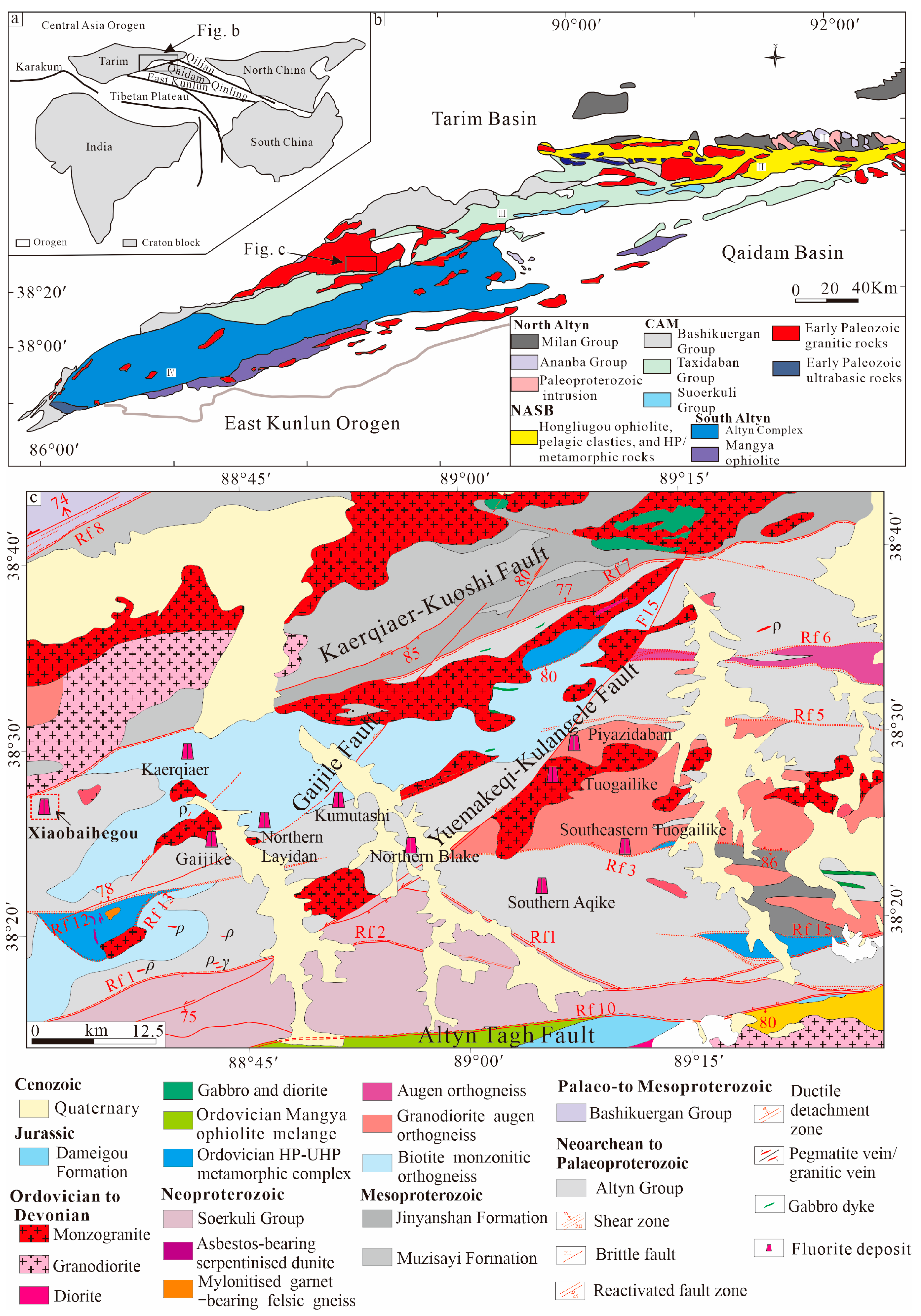
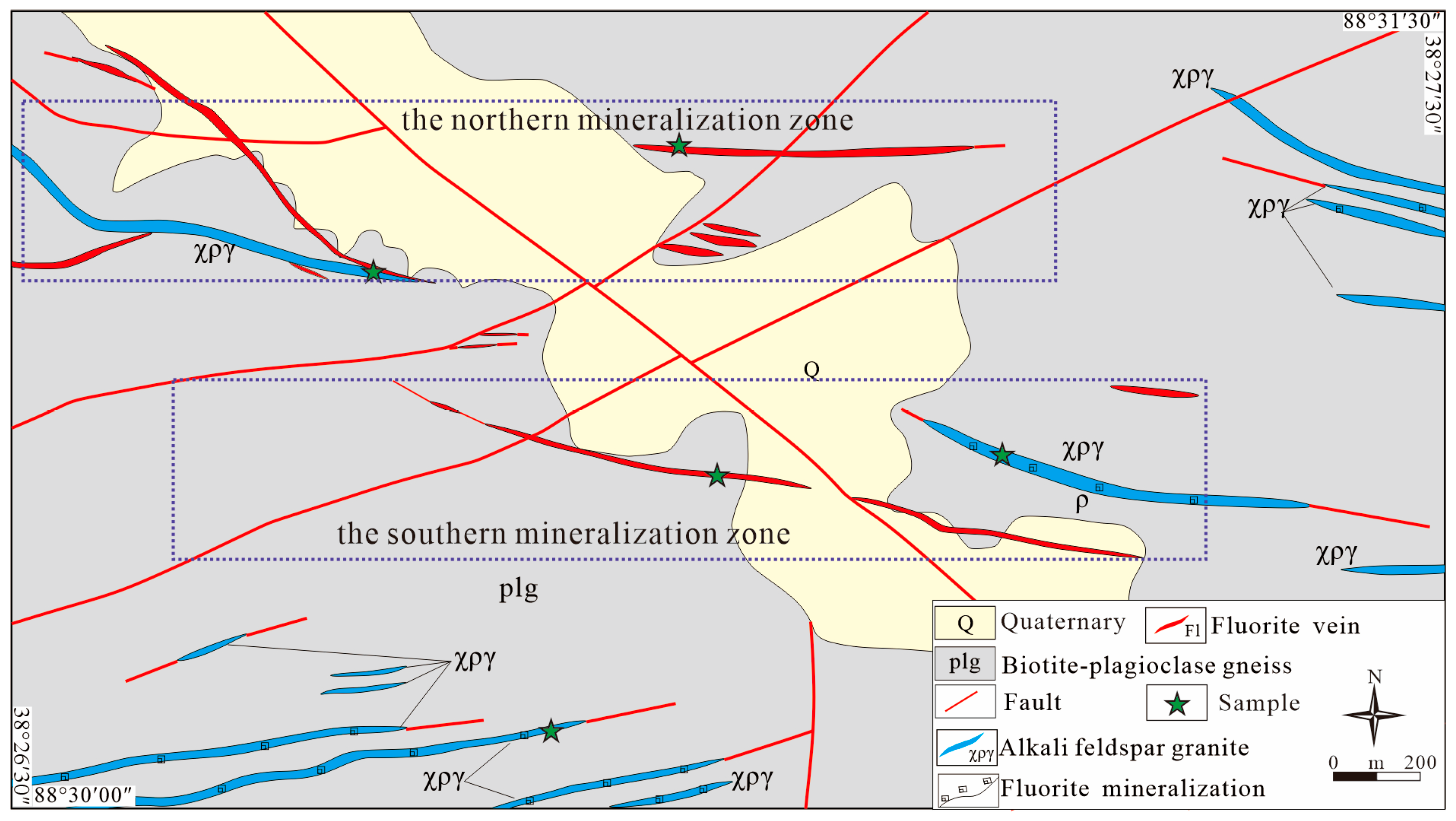
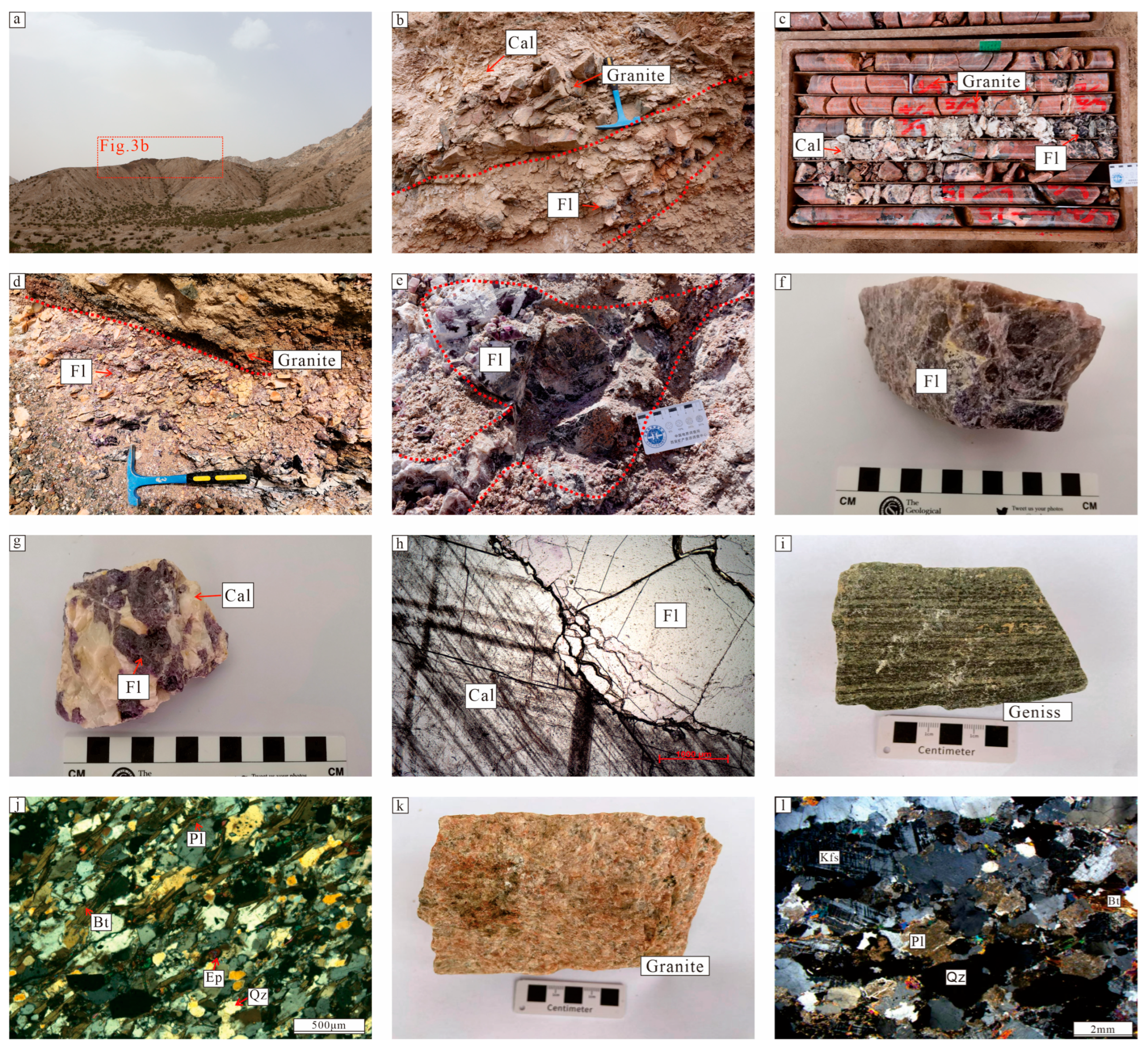
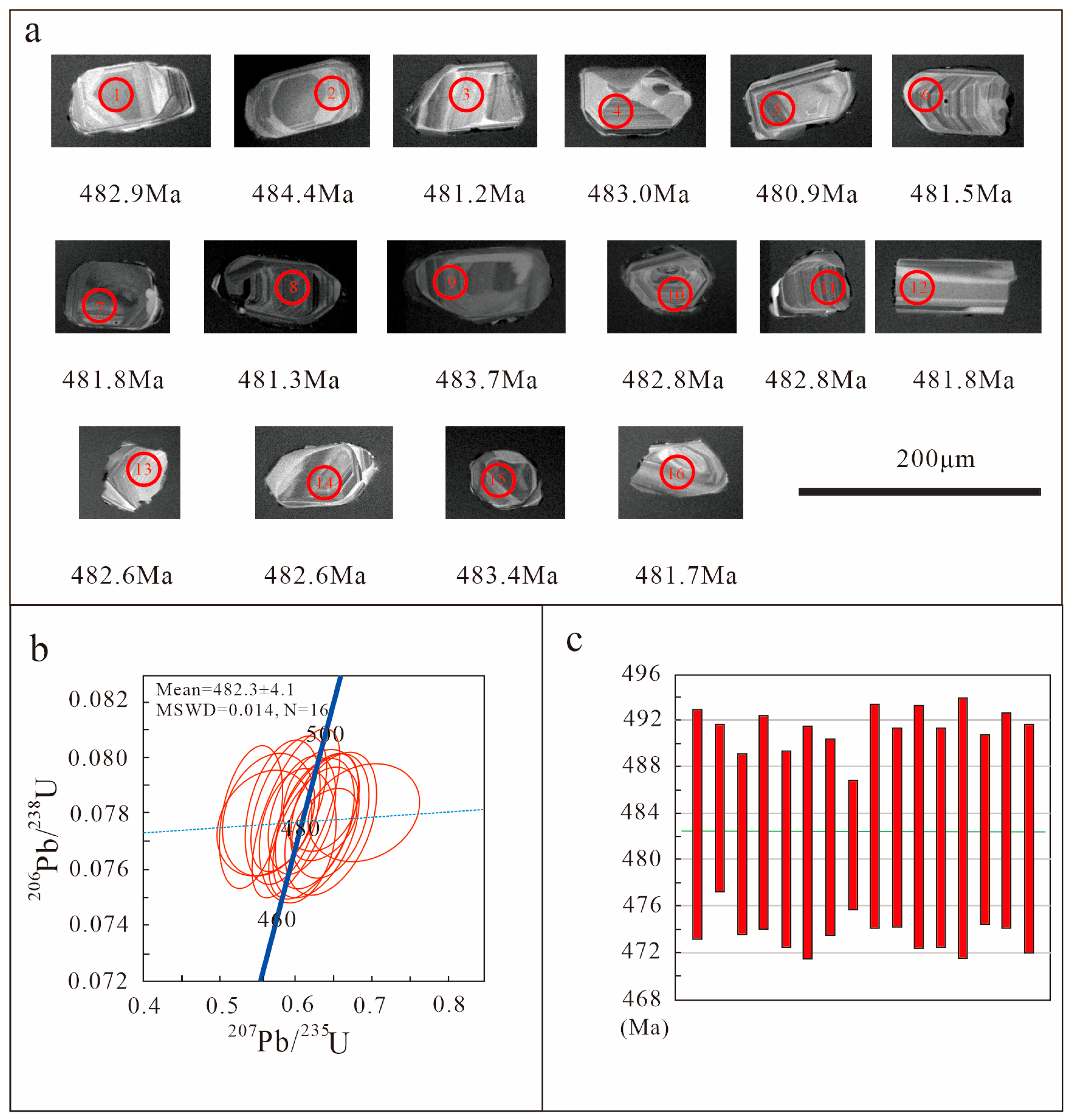

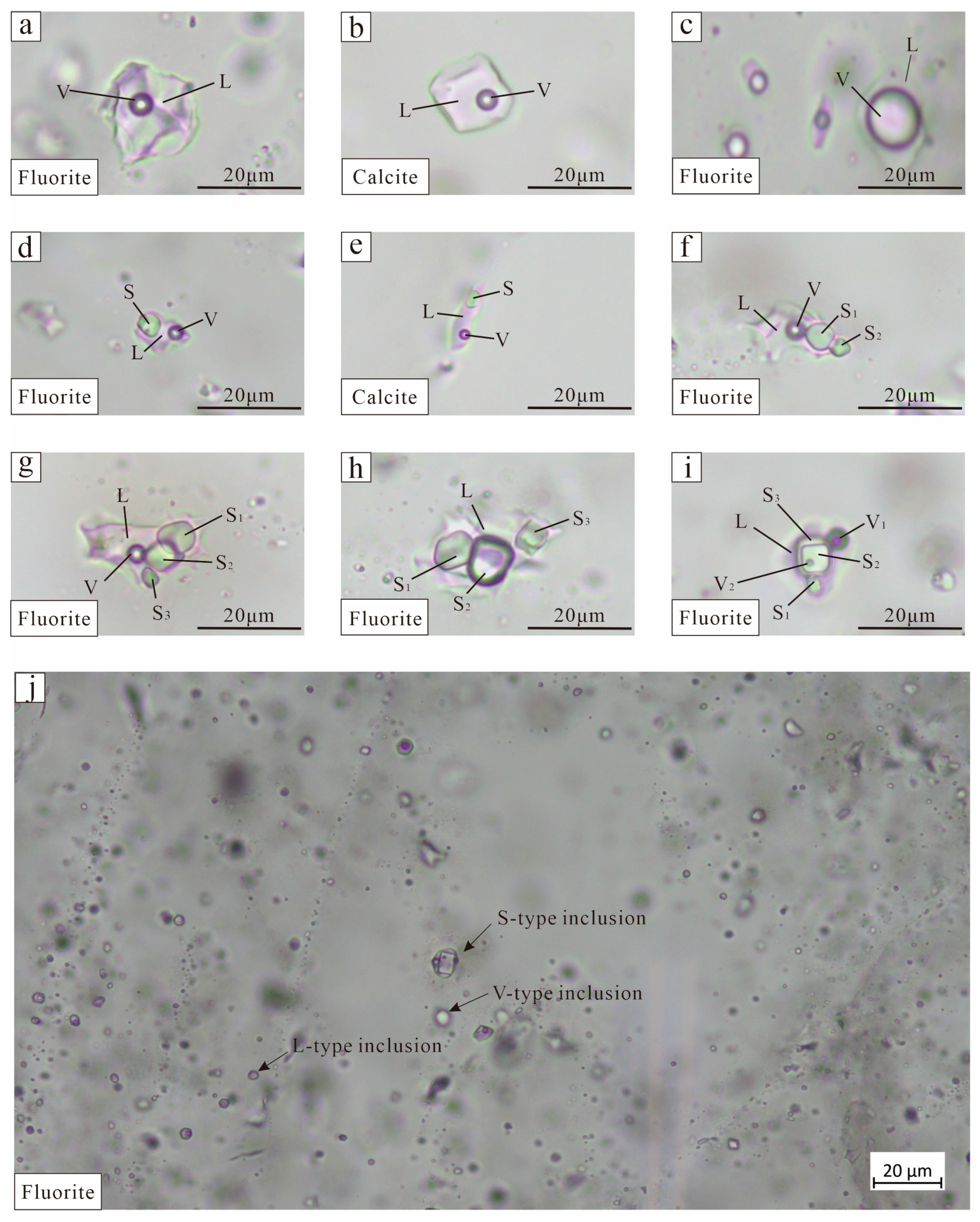
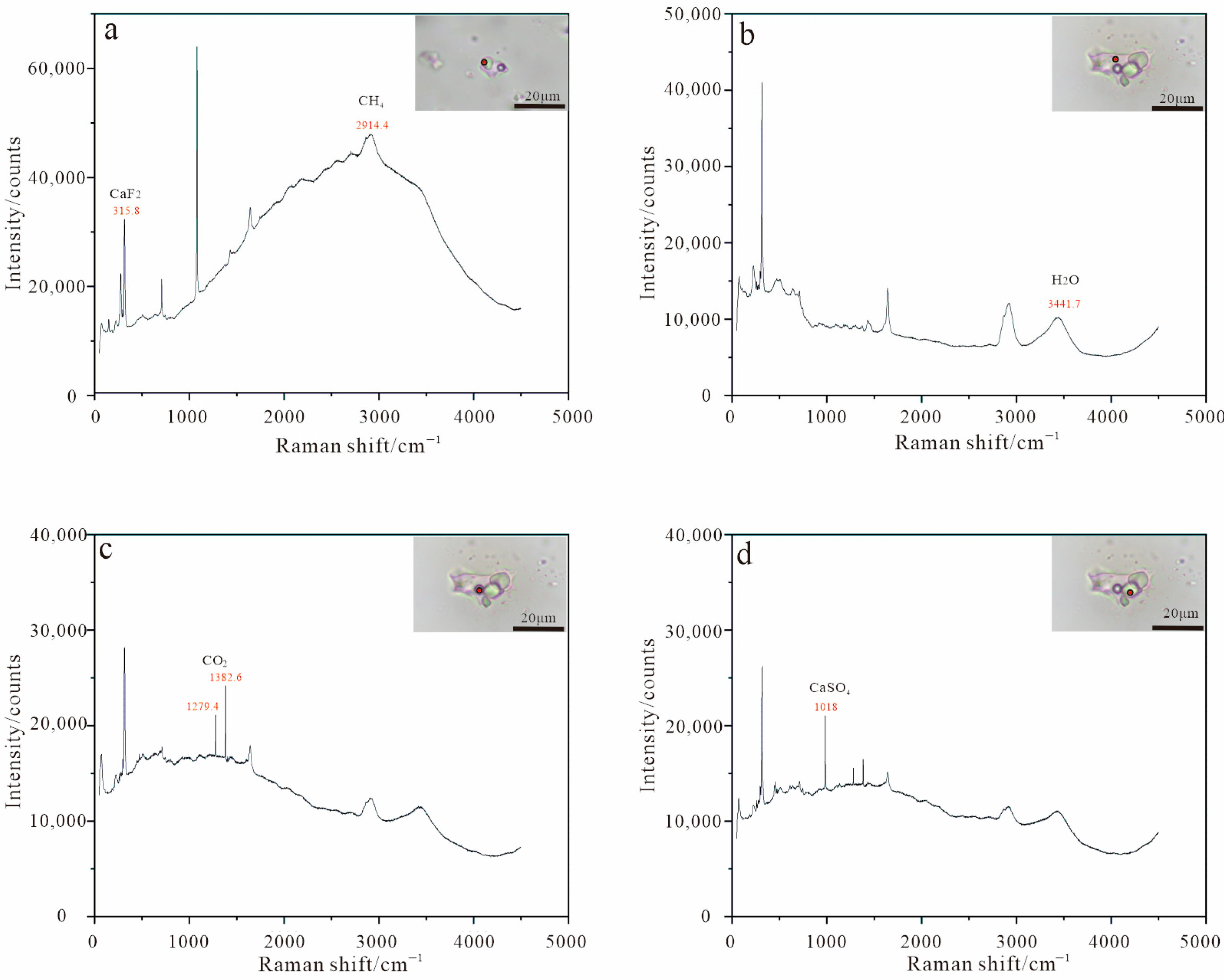
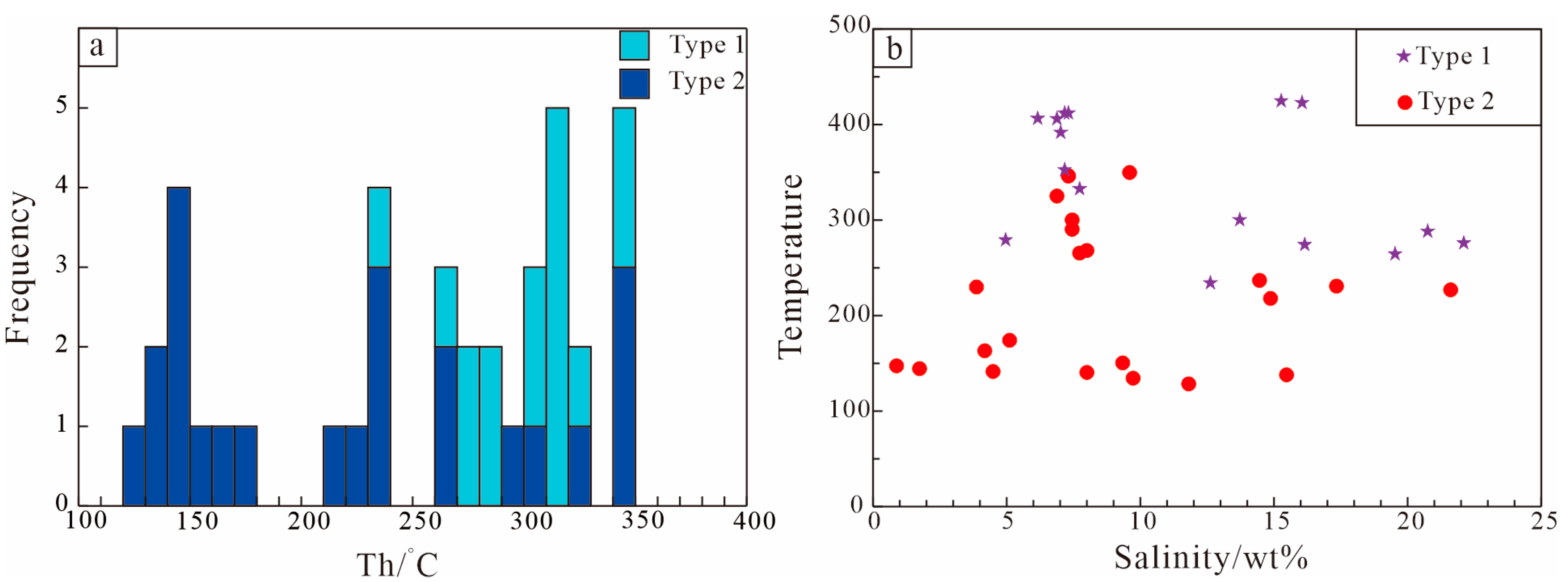


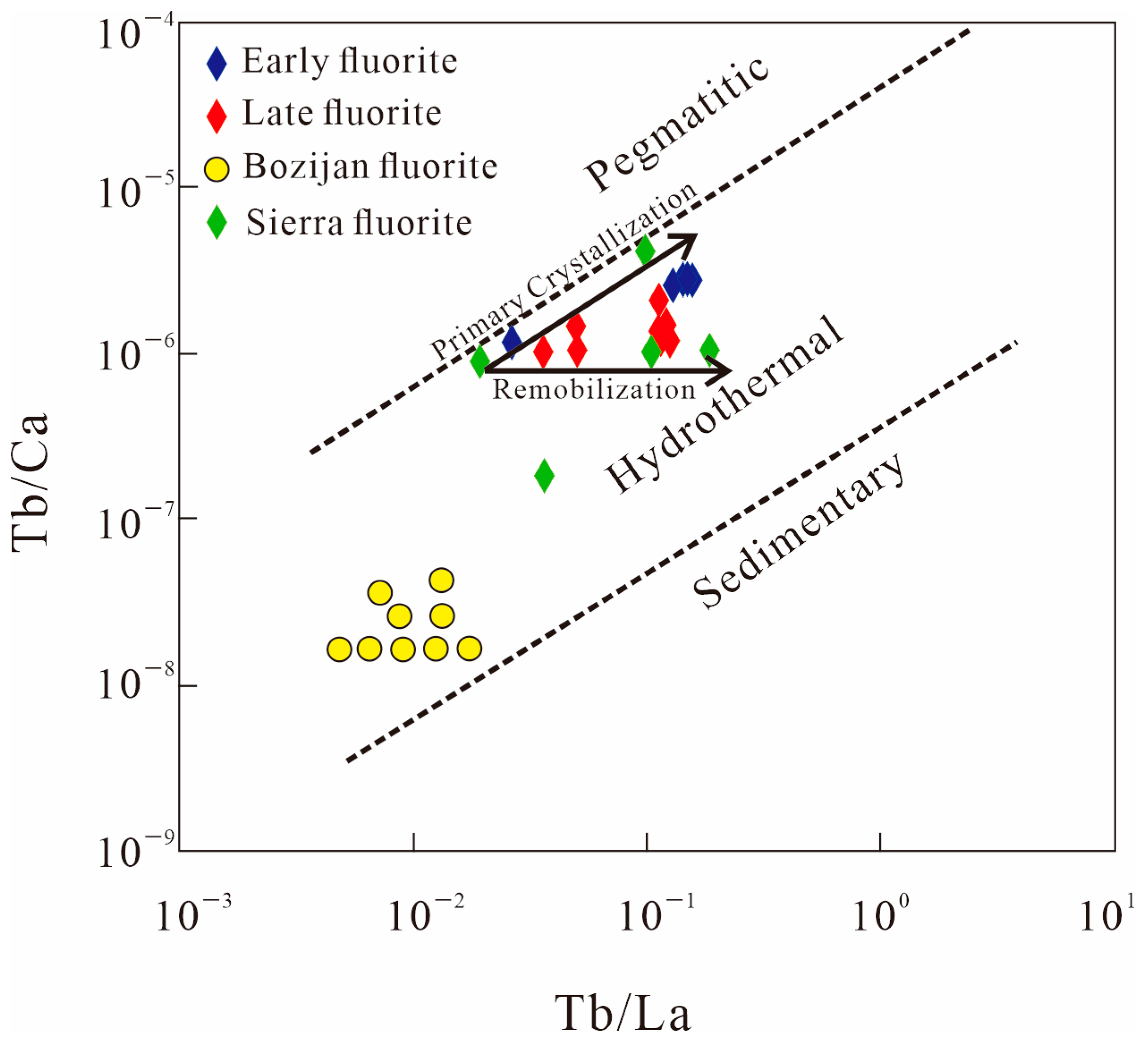


| Spot NO. | Th | U | Th/U | Corrected Isotopic Ratios | Age (Ma) | ||||||||||
|---|---|---|---|---|---|---|---|---|---|---|---|---|---|---|---|
| (×10−6) | 207Pb/206Pb | 1σ | 207Pb/235U | 1σ | 206Pb/238U | 1σ | 207Pb/206Pb | 1σ | 207Pb/235U | 1σ | 206Pb/238U | 1σ | |||
| XBH-01 | 2050 | 4918 | 0.42 | 0.05047 | 0.00278 | 0.53884 | 0.02857 | 0.07779 | 0.00164 | 217 | 128 | 438 | 19 | 483 | 10 |
| XBH-02 | 1617 | 3243 | 0.50 | 0.06439 | 0.00483 | 0.68846 | 0.04887 | 0.07804 | 0.00117 | 754 | 159 | 532 | 29 | 484 | 7 |
| XBH-03 | 1188 | 3659 | 0.32 | 0.05176 | 0.00356 | 0.55384 | 0.03986 | 0.07750 | 0.00129 | 276 | 162 | 448 | 26 | 481 | 8 |
| XBH-04 | 1548 | 3013 | 0.51 | 0.05265 | 0.00380 | 0.56364 | 0.04307 | 0.07781 | 0.00154 | 322 | 169 | 454 | 28 | 483 | 9 |
| XBH-05 | 1914 | 4180 | 0.46 | 0.05365 | 0.00251 | 0.56999 | 0.02582 | 0.07746 | 0.00138 | 367 | 101 | 458 | 17 | 481 | 8 |
| XBH-06 | 1818 | 2800 | 0.65 | 0.06047 | 0.00389 | 0.64252 | 0.03973 | 0.07755 | 0.00163 | 620 | 139 | 504 | 25 | 481 | 10 |
| XBH-07 | 2068 | 4326 | 0.48 | 0.05367 | 0.00228 | 0.57639 | 0.02826 | 0.07761 | 0.00136 | 367 | 96 | 462 | 18 | 482 | 8 |
| XBH-08 | 3354 | 6681 | 0.50 | 0.05978 | 0.00270 | 0.63917 | 0.02894 | 0.07752 | 0.00092 | 594 | 103 | 502 | 18 | 481 | 5 |
| XBH-09 | 1538 | 3845 | 0.40 | 0.06053 | 0.00388 | 0.64604 | 0.04000 | 0.07791 | 0.00157 | 633 | 137 | 506 | 25 | 484 | 9 |
| XBH-10 | 1918 | 3404 | 0.56 | 0.05995 | 0.00356 | 0.63968 | 0.03679 | 0.07778 | 0.00141 | 611 | 123 | 502 | 23 | 483 | 8 |
| XBH-11 | 4182 | 8068 | 0.52 | 0.05540 | 0.00257 | 0.59081 | 0.02677 | 0.07777 | 0.00172 | 428 | 104 | 471 | 17 | 483 | 10 |
| XBH-12 | 1724 | 3192 | 0.54 | 0.05486 | 0.00319 | 0.58504 | 0.03441 | 0.07761 | 0.00155 | 406 | 99 | 468 | 22 | 482 | 9 |
| XBH-13 | 1010 | 2189 | 0.46 | 0.05594 | 0.00428 | 0.58865 | 0.04110 | 0.07773 | 0.00183 | 450 | 140 | 470 | 26 | 483 | 11 |
| XBH-14 | 3744 | 5272 | 0.71 | 0.05791 | 0.00329 | 0.62097 | 0.03554 | 0.07774 | 0.00133 | 528 | 129 | 490 | 22 | 483 | 8 |
| XBH-15 | 1367 | 2749 | 0.50 | 0.05758 | 0.00348 | 0.61788 | 0.03815 | 0.07786 | 0.00151 | 522 | 133 | 489 | 24 | 483 | 9 |
| XBH-16 | 1357 | 2284 | 0.59 | 0.05722 | 0.00419 | 0.60899 | 0.04310 | 0.07759 | 0.00162 | 502 | 161 | 483 | 27 | 482 | 10 |
| Deposit | Host Mineral | Numbers | Th (°C) (Main Range) | Salinity (wt.%) (Main Range) | Density (g/cm3) | Date Sources |
|---|---|---|---|---|---|---|
| Xiaobaihegou | Early-stage Fluorite | 9 | 235~426 | 28.59~42.40 | 0.93~1.03 | this study |
| Late-stage Fluorite | 23 | 129~350 | 0.88~21.61 | 0.61~0.93 | ||
| Kumutashi | Early-stage Fluorite | 13 | 225~390 | 5.20~8.91 | 0.63~0.88 | [29] |
| Late-stage Fluorite | 16 | 117~215 | 0.53~12.73 | 0.89~1.02 | ||
| Kaerqiaer | Fluorite | 37 | 135~359 | 2.07~3.87 | / | [8] |
| Sample | δ13CV-PDB (‰) | δ18OV-PDB (‰) | δ18OSMOW (‰) |
|---|---|---|---|
| XB-01 | −6 | −15.13 | 15.31 |
| XB-02 | −6.01 | −14.99 | 15.46 |
| XB-03 | −6.04 | −14.88 | 15.57 |
| XB-04 | −5.01 | −18.6 | 11.74 |
| XB-05 | −4.98 | −18.8 | 11.53 |
| XB-06 | −4.93 | −18.36 | 11.99 |
| XB-07 | −4.31 | −18.89 | 11.44 |
| XB-08 | −4.31 | −18.89 | 11.44 |
| XB-09 | −4.36 | −18.75 | 11.58 |
| XB-10 | −5.36 | −11.6 | 18.95 |
| XB-11 | −5.57 | −16.14 | 14.27 |
| XB-12 | −5.23 | −20.09 | 10.2 |
| XB-13 | −4.06 | −20.01 | 10.28 |
| XB-14 | −4.73 | −20.41 | 9.87 |
| XB-15 | −9.53 | −13.56 | 16.93 |
| XB-16 | −5.19 | −20.22 | 10.07 |
| XB-17 | −5.21 | −20.51 | 9.76 |
| XB-18 | −6.38 | −13.06 | 17.45 |
| XB-19 | −3.75 | −19.01 | 11.31 |
| Sample | δDV-SMOW (‰) | δ18OV-SMOW (‰) |
|---|---|---|
| XB-01 | −91.1 | 0.5 |
| XB-02 | −88.2 | 0.4 |
| XB-03 | −85.4 | −1.4 |
| XB-04 | −85.8 | −1.1 |
| XB-05 | −72.6 | −3.6 |
| XB-06 | −70.8 | −3.2 |
| XB-07 | −81.9 | −9.3 |
| XB-08 | −83.2 | −9.4 |
| XB-09 | −85.1 | −2.2 |
| XB-10 | −47.9 | −3.6 |
| XB-11 | −49.7 | −3.1 |
| Sample | Mineral | Rb/10−6 | Sr/10−6 | Rb/Sr | 87Sr/86Sr | Sm/10−6 | Nd/10−6 | 147Sm/144Nd | 143Nd/144Nd |
|---|---|---|---|---|---|---|---|---|---|
| XB-01 | Fluorite | 49.8 | 348 | 0.14 | 0.712717 | 3.61 | 19.3 | 0.1129 | 0.511946 |
| XB-02 | Fluorite | 23.2 | 384 | 0.06 | 0.711282 | 2.78 | 12.9 | 0.1299 | 0.511988 |
| XB-03 | Fluorite | 5.46 | 419 | 0.01 | 0.710491 | 3.70 | 16.3 | 0.1370 | 0.512009 |
| XB-04 | Fluorite | 6.22 | 388 | 0.02 | 0.710756 | 4.80 | 17.5 | 0.1654 | 0.512073 |
| XB-05 | Fluorite | 3.70 | 425 | 0.01 | 0.710332 | 2.68 | 11.4 | 0.1421 | 0.512005 |
Disclaimer/Publisher’s Note: The statements, opinions and data contained in all publications are solely those of the individual author(s) and contributor(s) and not of MDPI and/or the editor(s). MDPI and/or the editor(s) disclaim responsibility for any injury to people or property resulting from any ideas, methods, instructions or products referred to in the content. |
© 2025 by the authors. Licensee MDPI, Basel, Switzerland. This article is an open access article distributed under the terms and conditions of the Creative Commons Attribution (CC BY) license (https://creativecommons.org/licenses/by/4.0/).
Share and Cite
Chen, K.; Song, W.; Wang, Y.; Zhang, L.; Jing, Y.; Zhang, Y.; Gao, Y.; Liu, M.; Deng, N.; Wu, J. The Source and Evolution of Ore-Forming Fluids in the Xiaobaihegou Fluorite Deposit, Altyn-Tagh Orogen, NW China: Constraints from Trace Element, Fluid Inclusion, and Isotope Studies. Minerals 2025, 15, 840. https://doi.org/10.3390/min15080840
Chen K, Song W, Wang Y, Zhang L, Jing Y, Zhang Y, Gao Y, Liu M, Deng N, Wu J. The Source and Evolution of Ore-Forming Fluids in the Xiaobaihegou Fluorite Deposit, Altyn-Tagh Orogen, NW China: Constraints from Trace Element, Fluid Inclusion, and Isotope Studies. Minerals. 2025; 15(8):840. https://doi.org/10.3390/min15080840
Chicago/Turabian StyleChen, Kang, Wenlei Song, Yuanwei Wang, Long Zhang, Yongkang Jing, Yi Zhang, Yongbao Gao, Ming Liu, Nan Deng, and Junwei Wu. 2025. "The Source and Evolution of Ore-Forming Fluids in the Xiaobaihegou Fluorite Deposit, Altyn-Tagh Orogen, NW China: Constraints from Trace Element, Fluid Inclusion, and Isotope Studies" Minerals 15, no. 8: 840. https://doi.org/10.3390/min15080840
APA StyleChen, K., Song, W., Wang, Y., Zhang, L., Jing, Y., Zhang, Y., Gao, Y., Liu, M., Deng, N., & Wu, J. (2025). The Source and Evolution of Ore-Forming Fluids in the Xiaobaihegou Fluorite Deposit, Altyn-Tagh Orogen, NW China: Constraints from Trace Element, Fluid Inclusion, and Isotope Studies. Minerals, 15(8), 840. https://doi.org/10.3390/min15080840






